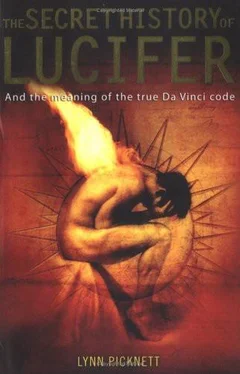It is almost certainly Leonardo's own face (see illustrations). He loved putting himself in his works - such as in the bottom righthand corner of The Adoration of the Magi or as Saint Thaddeus/Saint Jude in the Last Supper: the joke no doubt being that Saint Jude is patron saint of lost causes. It is even possible to see that Saint Jude's face is very similar to that of Shroudman, from the distinctive hairline to the large, knobbly nose.
Various other devotees to the idea that Leonardo faked the Shroud" have suggested that he used his own face out of reverence for Jesus, literally in imitation of Christ. However, even leaving his personal heretical beliefs aside for the moment, from the viewpoint of his time and place that is simply inconceivable. He has represented himself splattered with Christ's holy blood, believed to be sacred and redemptive: to fake it would be absolute sacrilege. It would have been impossible for a believer, a true son of the Church, to have taken such a far-reaching liberty with the face and body of the Redeemer. To have faked Christ's broken and bloody body was neither for the squeamish nor anyone who entertained any hope of ever seeing Heaven. On the other hand, a passionate dyed-in-thewool `anti-Christ' would have welcomed the chance to render Jesus not only mortal, but also made in his own image - and Leonardo was quick to take such an opportunity. Not only did he think of himself as Grandson of God, but clearly had ambitions to be his own father! (For the illegitimate artist who suffered at the hands of his half siblings, especially over vexed problems of inheritance, presenting himself as the alleged Son of God would have had an extra piquancy. Unfortunately, this particular association passed Sigmund Freud by.)
Of course, from an objective viewpoint, with the Turin Shroud Leonardo succeeded brilliantly, even though he could never have known that in the late nineteenth century his `magic' image would suddenly leap into incredible detail when it was photographed for the first time and seen in negative 52 (Although it seems unlikely, did Leonardo himself have some means of seeing Shroudman in negative? Did he know that he had created such a work of Luciferan genius - or was it merely a shot in the dark, a species of message in a bottle thrown into the seas of posterity with the hope that one day it would be recognized for what it is?)
As for the image of the terribly beaten and nailed body, that presumably came from unholy tinkerings with scourge, hammer and nails behind closed doors with one of the many corpses Leonardo used for anatomical research. This is an actual body that really had been subjected to the great abuses of beating, scourging and the dreadful piercing of hands, side and feet. (The head bears the marks of the Crown of Thorns, but perfectionist Leonardo would have endured the pain for the sake of his heretical art. In fact, the face itself is remarkably free from wounds and certainly far too composed for a man who had allegedly been tortured to death.) The body had truly been nailed upright, for the nail wounds are in the wrists and not the palms, showing a grim practicality. (Incredibly, some Shroudies have even suggested that no one could have known how to recreate the wounds of the crucifixion. Yet surely all one has to do is read the New Testament, which describes what happened to Jesus - and boldly set about some grisly experimentation.) And, although Leonardo never painted a crucifixion, there is an intriguing reference in a note that has long puzzled biographers, dating from c. 1489 that refers to a specimen that he had borrowed: .. the bone that Gian de Bellinzona pierced and from which he easily extracted the nail ...'S3 It seems that Leonardo was experimenting with crucifixion for some nefarious purpose of his own.
It is significant that while there is no paint to speak of54 on the Shroud, there is real blood around the sites of the wounds. A painstaking - not to say nit-picking - genius, Leonardo was unlikely to spoil his masterpiece by splodging it with crude daubs of paint instead of blood. (Similarly, of all fakers a perfectionist of his genius would hardly have used linen straight from the loom for a relic that was supposed to be 1,500 years old.) So it might be said, albeit perhaps melodramatically, that in one sense at least he did sign away his soul to Lucifer in blood.
Faking the `Shroud' of Turin was, arguably, Da Vinci's greatest hour - certainly as a Luciferan, whether one takes that to mean an agent of the Devil, as would most Catholics and all Shroudies, or merely as a daring experimental scientist. The fake is an astonishing joke - truly a commedia, a profoundly serious comment - but in this case, also a brutal nose-thumbing at the Church, even at its founder. As his first biographer, Giorgio Vasari, wrote: `Leonardo formed . .. a doctrine so heretical that he depended no more on ... any religion', although perhaps prudently this passage was removed from subsequent editions, being replaced by a brief and unconvincing note about Leonardo's death-bed repentance."
Never officially endorsed by the Vatican, although it has come close once or twice, the Shroud for the most part is kept locked away from prying eyes and the depredations of modern life and the polluting air. From time to time it is displayed in the cathedral at Turin, where no doubt the shade of the old master enjoys the religious raptures of the pilgrims crossing themselves and murmuring devout prayers over a photograph of a sixteenthcentury Johannite heretic.
Even to a non-Christian, the sheer chutzpah involved is breathtaking, almost shocking in both the literal and figurative sense. The image of the Shroud, particularly in minutely detailed negative, induces that peculiar abrupt lurching in the pit of the stomach that marks an encounter with something truly outrageous - as in suddenly seeing for oneself what he did with the dark rocks looming above the Virgin's head. Coming face-to-face with Leonardo's wilful, brilliant and intentionally blasphemous masterpiece is a moment of truth that many would rather not experience.
Nor could Leonardo have guessed at another extraordinary sideeffect of using his own face as the model for Christ on the Shroud - although no doubt he would have exploded with laughter if he had. Although there had been depictions of Jesus as bearded before the Turin Shroud went on display in the late fifteenth century, after that watershed Christ's appearance in popular art changed specifically to resemble it. Suddenly the divine look was standardized into a very tall (although never quite so tall as Shroudman, for obvious reasons), broad-shouldered man with reddish hair parted in the middle, a long nose and hauntingly beautiful, regular features. In other words, our general cultural perception of what Jesus looked like is none other than Leonardo - another shocking triumph for the inspiration of The Da Vinci Code. Just think of all those plaster statues, the countless stained-glass windows and twisted bodies on crucifixes not as images of a first-century Jewish teacher and mage at all, but a fourteenth-fifteenth-century Italian homosexual heretic who hated Christ with all his Johannite heart. Again, there is that disturbing shift in the pit of the stomach, as yet again the foundation of our collective unconscious lifts - and shudders slightly.
One day the `Shroud' may be prominently displayed where it belongs - in a museum of photography or science and technology, where the fruits of the Da Vinci heresy can be freely appreciated for what they are, far away from pilgrims, priests, candles and incense. The Shroud does not deserve to be prayed over, but then perhaps nothing does.
Behind closed doors
Although the authorities' suppression of scientific experiment and intellectual enquiry from the early days of Christianity to the Age of Enlightenment was patchily inconsistent - depending largely on the attitude to learning of each individual pope - it is true to say that in general the Church frowned on too much knowledge, debate and thinking. And it surely is no coincidence that the Latin and Greek for `knowledge' - respectively scientia and gnosis - represent the two aspects of learning that it most abhorred. As a blend of much that was anathematized, being a left-handed-gay-vegetarian- Johannite-photographer-aviator-anatomist, Leonardo got away with an enormous amount, due mostly to friends in high places, but even he often thought it prudent to move from place to place quite quickly from time to time. (It was only at the end of his life, in 1513, when Pope Leo X began to express his distaste for Leonardo's anatomical work that he ceased his obsessive dissection in hospitals, charnel houses and graveyards.)
Читать дальше












